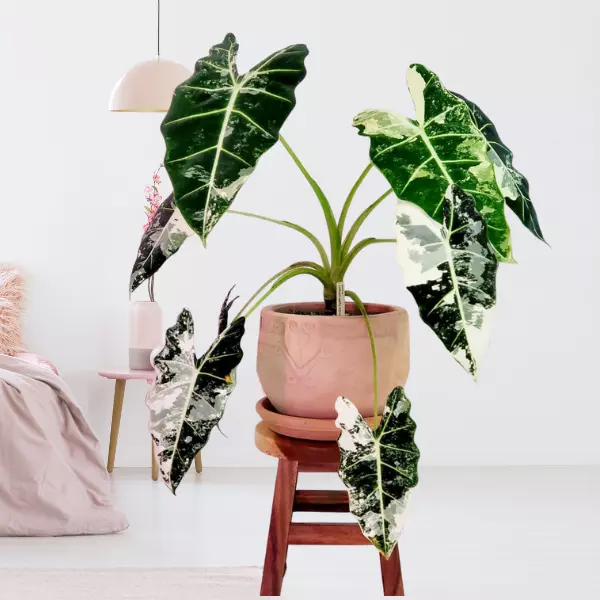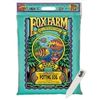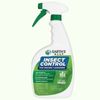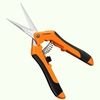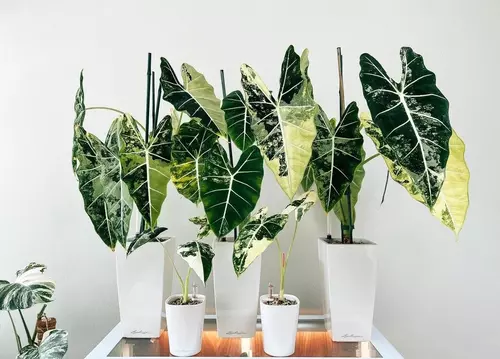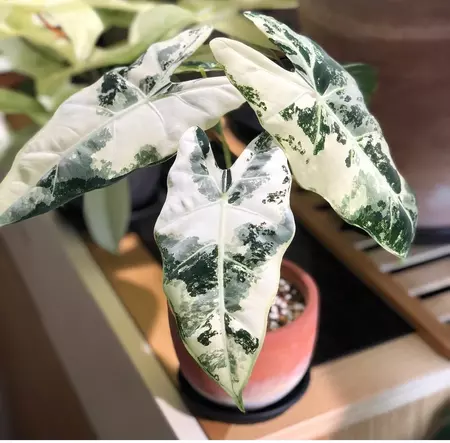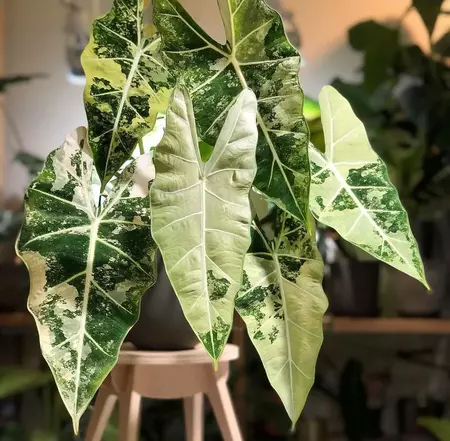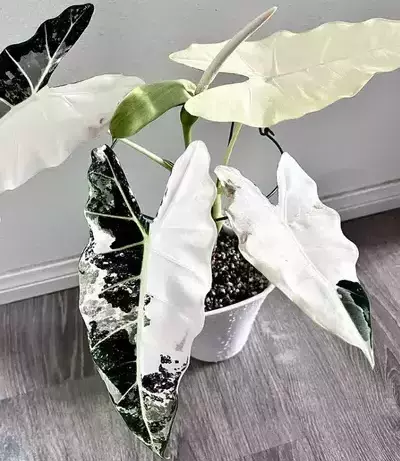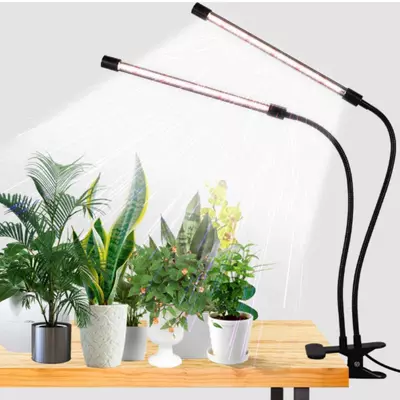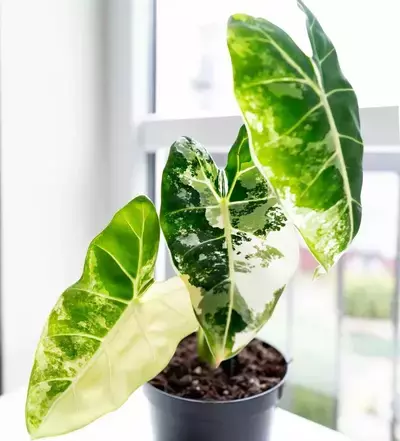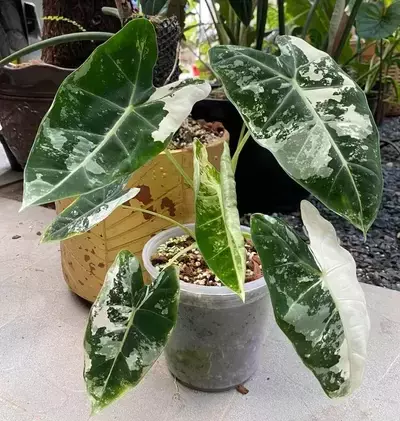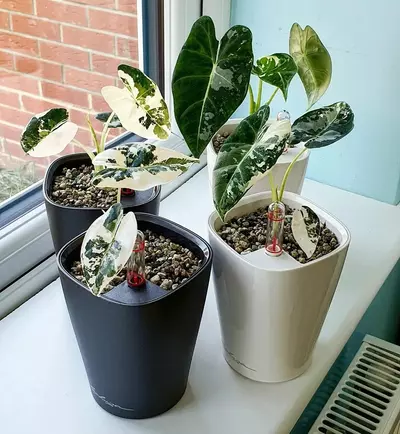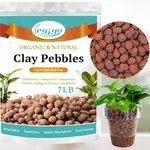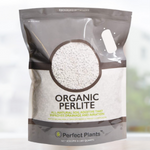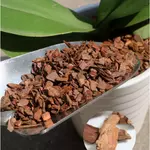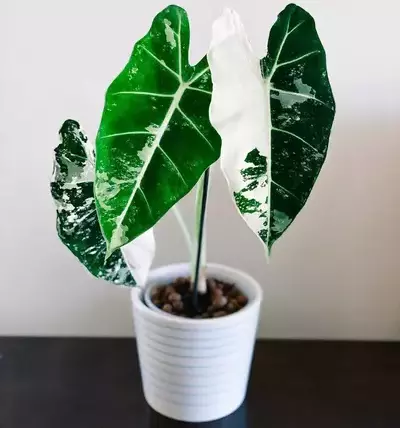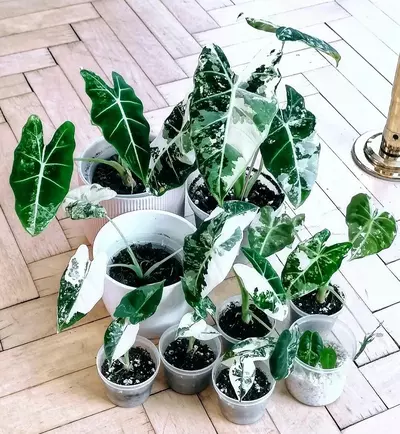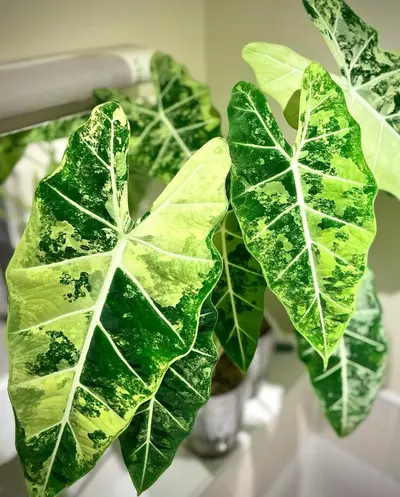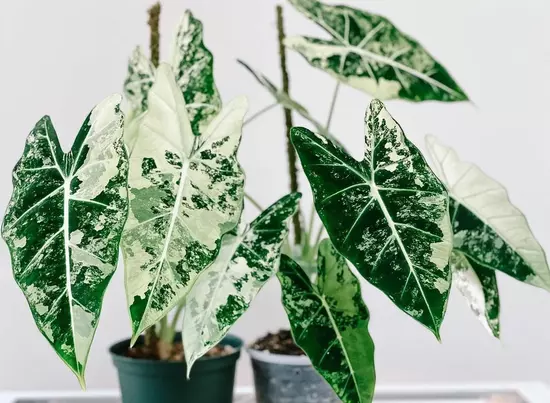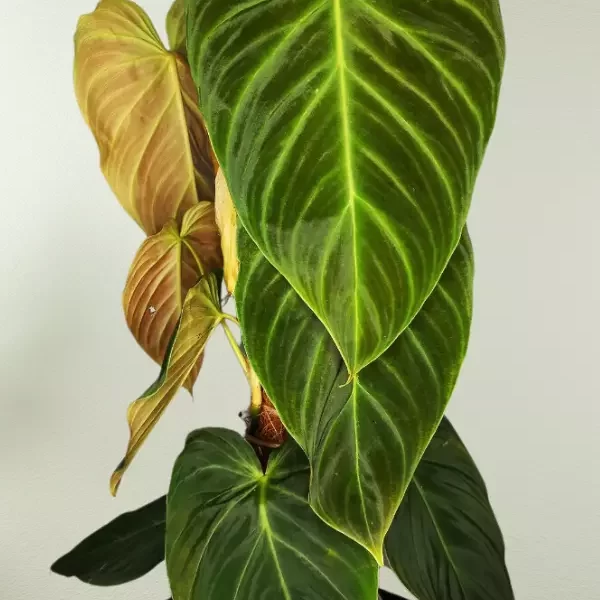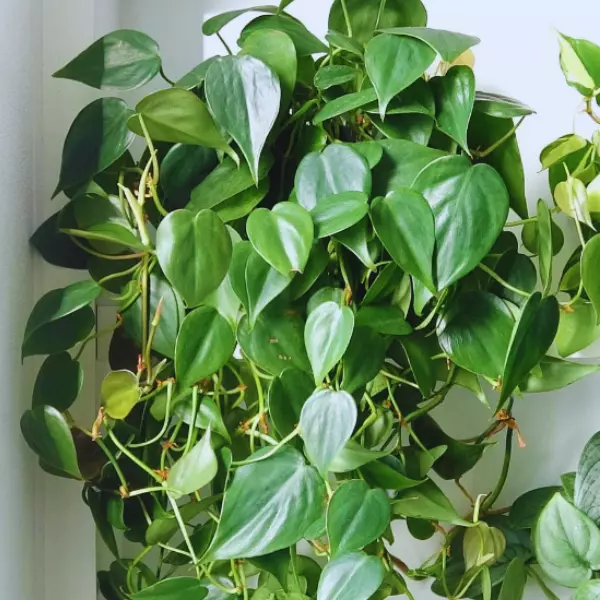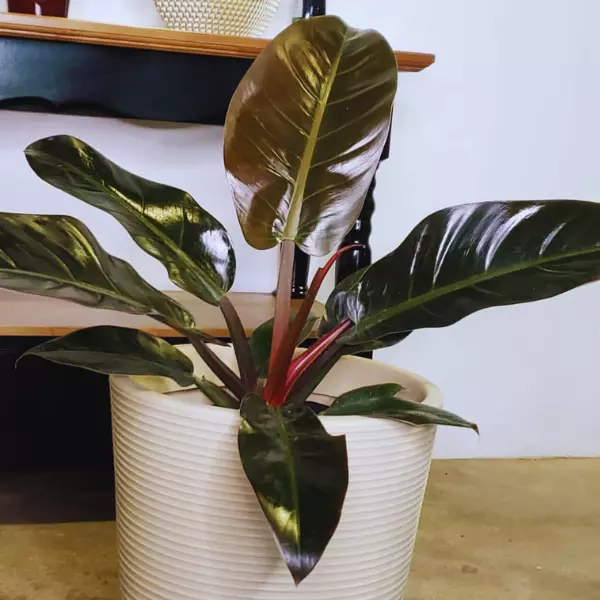Alocasia Frydek Variegated is the most exotic, ultra-rare, and magnificent variety of the Araceae family, featuring an exquisite, stunning, luxurious velvety appearance that would leave anyone to fall in love with this beauty. This plant exhibits soft, velvety broad heart-shaped leaves featuring dark green color contrasting silver-white sectoral splotches and prominent ivory venation, giving the plant a truly glamorous look. The long, pointy, wavy edged leaves sits on succulent light green petioles emerging from a single stump or rhizome. Alocasia Frydek Variegated is a highly desirable, magnificent, rare collector’s Aroid on the Wishlist of every plant lover.
Allied Species: Alocasia Frydek, Alocasia Macrorrhiza Variegata, Alocasia Sarian, Alocasia Pink Dragon, Alocasia Cucullata, Alocasia Silver Dragon, Alocasia Stingray, Alocasia Regal Shields, Alocasia Nebula, Alocasia Maharani, Alocasia Jacklyn, Alocasia Zebrina,
Essential Products
Habitat & Ecology
Alocasia Frydek Variegated is a tropical plant belonging to the warm climates of Southeast Asia. This plant is a great way to add a tropical touch to your home.
The Alocasia Frydek variegated is known by many other names, such as Alocasia Micholitziana Frydek and Frydek Elephant Ear. To clear a common misunderstanding, Micholitziana is the specie, and Alocasia Micholitziana ‘Frydek’ is a rare variegated cultivar of Alocasia Micholitziana. However, its counterpart Alocasia Micholitziana ‘Maxkowskii’ or Green Velvet Alocasia is widely sold under the incorrect cultivar name of Alocasia Micholitziana ‘Frydek.’ In this care guide, we will use the name Alocasia Frydek Variegated.
| Botanical Name: | Alocasia Micholitziana ‘Frydek’ |
| Family Name: | Araceae |
| Common names: | Alocasia Frydek Variegated, Frydek elephant ear |
| Origin | Southeast Asia |
| Plant Size | 3 ft. (1 m) tall and leaves grow up to 18” (45 cm) long |
| Temperature | 65F-85F |
| Humidity | 90% and above |
| Light Need | Bright indirect sunlight |
| Soil Type | Well-draining |
| Plant Type | Tuberous or rhizomeous perennials |
| Flower Inflorescence | Green and White inflorescence |
| Propagation | Basal Offset Division, Corms, stem or tuber cutting |
| Pest and diseases | Spider mites, Aphids, Scale |
| Diseases | Root rot, leaf spot diseases |
Is variegation stable in Alocasia Frydek?
The variegation pattern in Alocasia Frydek variegated is highly unstable as one leaf will grow up to be all green, another will be all white, and another leaf will be splotched, but this irregular variegation makes it the most stunning and one-of-a-kind Alocasia in the Araceae family.
Half moon and full moon leaves are the main attraction and the reason why it is widely popular. Some gardeners consider it the most stunning and luscious variety of Alocasia, bringing a formal and dramatic look to an office, home, or garden wherever placed. However, variegation stability depends on the mother plant. A dome of cells creates the entire plant called the apical meristem, and the variegation on a particular leaf or on the entire plant is only part of that dome. So as that dome grows out and turns into an entire plant, pieces of it go variegated, and other pieces stay green.
How do you care for Alocasia Frydek variegated?
Alocasia Frydek variegated has gained massive popularity over the last few years, and that’s all for the right reasons. Keeping it healthy and thriving is sometimes overwhelming for some plant parents, especially beginners, but with proper care, this plant may amaze you with its spectacular long variegated foliage. I find Alocasia Frydek variegated, not demanding, but sensitive to watering frequency.
It needs abundant bright indirect light with high humidity, nearly 90%, and a well-draining potting mix. In addition, the plant loves warmth, a temperature of roughly 68 degrees Fahrenheit and regular watering once the soil nearly dries completely. Fertilizing it once a month during the growing season is beneficial for its development.
This article will cover every aspect related to Alocasia Frydek’s variegated. Let’s start with the care guide for this striking beauty.
This stunning Alocasia is known for its demanding nature may be due its price tag. However, good news is its not that fussy its know to be, and can thrive in the right growing conditions such as lot of light and humidity. Let’s look in details all the care aspects to grow Alocasia Micholitziana ‘Frydek’ Variegated indoors successfully to add a tropical vibe to your home.

Growth and Size
Alocasia Frydek variegated is a luxurious houseplant that can grow up to two to three feet in height in optimum conditions. The stunning elongated arrow-shaped leaves siting on the petioles growing from a rhizome or tuber, are the center of attraction, which can grow up to 18 inches (45 cm) long; that’s why they are nicknamed Elephant ears.
In optimal conditions such as warm, humid, bright light, Alocasia Micholitziana ‘Frydek’ Variegated tends to produce new leaves every few weeks but like other Alocsias, it tends to drop off older leaves to replace with new growth. The main tuber or Rhizome of Variegated Frydek may have four or five leaves at one time. Frydek puts out more offsets and pups as they grow which makes the plant bushier and fill the pot over time. Alocasia Frydek variegated can also be grown outdoors as a tender perennial in sheltered spots where it can receive morning or evening sunlight.
Flowering
Alocasia Frydek Vaiegated occasionally produces inflorescences- white and green spathe and spadix emerging from the center of the plant but they are relatively inconspicuous compared to its striking foliage. However, you can pollinate these flowers to produce seeds to propagate.

How often should I water my Frydek Variegated?
Alocasia Frydek variegated has thick stems that give it succulent-like properties, but at the same time, it can’t tolerate drought. Hence, it’s a bit tricky to keep this plant happy. In addition, the roots of green velvet are very sensitive to water; therefore, it’s recommended to provide abundant light and appropriate watering to prevent the soil from getting soggy or drying out too much. I have noticed that, unlike other Alocasias, Frydek Variegated likes to dry out a bit between waterings.
In the growing season, the plant needs more water but ensure to drain the excess water entirely, as roots can’t grow healthy while sitting in wet soil. Conversely, the Frydek doesn’t need much water in the winter season as it is dormant and does not grow new leaves; therefore, cut back the watering frequency accordingly.
When to water?
By following a few methods, you can water your plant accurately. The sip or drip watering method is an effective technique to prevent the plant from overwatering or underwatering. This mode allows you to water the plant in small amounts quite often to maintain a suitable aggregate of water.
However, check the soil before watering by dipping your finger in the potting soil; if the top 2 inches feel dry, your plant is ready to drink water. You can also determine the plant’s watering needs by checking the container’s weight. Lift the pot; if it feels lighter, it means you need to water the plant. Moreover, you can use a moisture meter to check the dryness of the soil before you water your plant.
Overwatering can be deadly for the plant as it can cause many diseases, such as root rot and other fungal infections. On the other hand, underwatering also harms the plant; its growth hampers and can result in dormancy.
Use a right-sized container to prevent overwatering; the pot should have proper drainage holes to drain out excess water. A potting mix also plays a vital role in confronting this problem; make sure you use a well-draining and aerated potting mix to avoid wet and dense substrate that may suffocate the roots.

Light Need
Your lovely Alocasia Frydek variegated needs a lot of bright and indirect light for its growth and development. This means that the plant craves light as the white variegated portions of leaves don’t have chlorophyll and can not photosynthesize. Therefore, exposing your plant to bright indirect light for more extended hours lets the plant photosynthesize and produce the required energy to thrive.
Keeping this in mind, place the plant at a bright spot where it receives sufficient indirect light. We recommend placing the plant in west or south-facing locations a few feet away from a window where it can get plenty of light throughout the way. The east-facing window also works where it can receive less intense morning sunlight, depending on your region.
Moreover, you can supplement Alocasia Frydek Variegated with grow lights to help them thrive and keep the stable variegation. Lack of light can be a factor in reverting the Frydek- the leave turns entirely green to photosynthesize to produce enough food for the plant. The size and variegation of the Frydek Variegated highly depends on the amount of light it receives. You can also place your Frydek Variegated in an Ikea greenhouse cabinet to receive abundant light to stay happy and grow large leaves.
Effect of Light
If you want to keep your plant vibrant and fresh, keep it away from intense direct light, or else it can result in brown tips or edges of leaves. The white variegated portions of the leaves are highly sensitive to direct sunlight and can scorch if receives intense afternoon sunlight. Therefore, if you are growing Alocasia Frydek Variegated outside, keep it in a sheltered spot.
Similarly, insufficient light is also not good for the plant’s growth as it can slow down the progression, and your lovely plant may take a long to develop new leaves. Also, low light may turn the leaves yellow as the soil stays wet for a long time and doesn’t dry out completely, resulting in overwatering and root rot. Moreover, lack of light can make Alocasia Frydek leggy – long petioles stretching for light and small leaves.

Humidity and Temperature
As this plant hails from tropical and warm climates, it needs high humidity to flourish. Therefore, the ideal humidity level is at least 90% and above to keep Alocasia Frydek variegated, happy and thriving. However, it can tolerate up to 50% humidity but may suffer from brown-edged leaves.
If you have difficulty maintaining proper humid conditions around your green pal, use alternatives to increase the humidity levels. The most commonly used method is placing a humidifier near your plant, but if you aren’t a fan of humidifiers, keeping a pebble tray near the plant will also do the trick.
Another way is to mist the plant regularly to achieve certain levels. However, misting the Frydek frequently makes the velvety leaves susceptible to fungal spots. Grouping your plants together or placing the Frydek Variegated in the Ikea greenhouse cabinet help the plant receives the required humidity to thrive. But avoid crowding your plants because they need airflow; else may suffer from fungal leaf spots or pest infestation spread.
Temperature
Similarly, the plant needs warm conditions to thrive; therefore, maintaining a suitable temperature for this Alocasia is a must. The ideal temperature for Frydek variegate is 68 degrees Fahrenheit, but if it goes below this range, it may affect the green velvet growth. As a result, the plant may enter into a state of dormancy and experience sluggish growth. Likewise, too high a temperature isn’t suitable as it can burn the delicate Frydek and may lead to death.
Keep the plant at a place where it doesn’t receive sudden temperature fluctuations, as such changes may affect the Alocasia Frydek variegated growth. That said, keep it away from air conditioners, heaters, and frosty windows. In winter, when the temperature drops, bring your plant inside, as Frydek is not frost-tolerant. Keep Frydek Variegated on a heating mat in colder seasons; also, let the plant keep growing.

Soil Need
Well-draining and nutrient rich moist soil is a must for Alocasia Frydek Variegated plant. A surefire way to impede root rotting is that your plant is in a chunky, airy potting mix because soil that is too heavy or dense may retain too much water, leading to rot. Chunky components such as perlite, pumice, and bark allow for really good drainage and aeration of the roots. Although Frydek Variegated likes to stay in moist medium, but they don’t want to be compact in soggy and heavy soil, suffocating the roots.
Being rainforest dwellers, Alocasia Frydek grow in humus-rich soil; hence are heavy feeders. They thrive in organic-rich soil as their nutrient requirements are higher than many other houseplants. The nutrients help the plant grow large foliage, and drainage prevents the Frydek from root rot and other fungal diseases.
We recommend a potting mix with some amendments by adding some inorganic components to keep the medium light and airy.
Potting Mix Recipe
I usually prepare an organic-rich chunky potting mix for my Alocasia Frydek Variegated by adding the following ingredients;
Above mentioned components are the main ingredients of a potting mix, and if you want to go a little extra, you can add the following.
However, if you don’t want the hassle and prefer a ready-made potting mix, we highly recommend checking the following potting mixes;
Growing In Semi-Hydroponics
You can put Alocasia Frydek Variegated in semi-hydroponics such as LECA and PON as this plant seems to enjoys the soilless medium. The roots of Alocasia Frydek grows vigorously and can breath due to airpockets of PON and LECA medium. In start the plant may stress a bit but be patient with your Frydek, and it will push back.
I’ve got this in a substrate similar to Lechuza PON in a self-watering setup using Dyna grow foliage pro for nutrients! It has been growing super fast and is low maintenance for me. For LECA medium, I would suggest using a clear glass vase or jar to monitor root growth and catch up on any root rot in time. Moreover, please don’t use a very large or deep vase or jar, as it will not let LECA dry out, and you don’t want your plant roots to be consistently wet.
Steps to grow your Alocasia Frydek in LECA or PON
Related Products
Products | Name | Check Price |
Organic Perlite for Plants | ||
WONDER SOIL Organic | ||
Orchid Potting Bark Mulch |

Potting & Repotting
Alocasia Frydek variegated likes to be a bit root bound and doesn’t need repotting until it is indispensable. Though this plant has vigorous root growth and can grow up to several feet, it doesn’t require repotting before a year or two. It does well in small pots with a small amount of soil, but it’s also essential to check the plant regularly for any signs of distress and root bound. For example, if you see roots coming out of drainage holes and water quickly dries out after watering, these are the indications plant needs to be transplanted to a new container.
After you decide to go for rejuvenation, take this opportunity to check the plant’s roots and soil to find any corms before planting it in a new pot.
A guide for Rejuvenating

Propagation of Alocasia Frydek Variegated
Alocasia Frydek Variegated plant can be propagated in various ways, such as through corms, the tuber or (stump) stem cutting, Basel offset division and air-layering method.
For successful propagation , we recommend propagating Frydek in growing season as the plant is active and can tolerate any stress.
Propagation By Division
The division is the most common and successful propagation method for the Alocasia Frydek Variegated plant. Alocasia Frydek grows from a single rhizome bearing three to five leaves and petioles fanning out from a single stump. With time, it produces basal offsets or suckers (also called a pup) emerging from the mother plant and their rhizomes running horizontally under the soil, absorbing nutrients from the mother plant.
The offsets sprout a few leaves above and adventitious roots below, making the plant look bushier. You can divide these offsets once they have a good root system and surpass 25cm in height bearing at least two leaves.
Gently uproot the plant from its current pot and brush off the soil for better access to the rhizomes. Slowly wiggle away the offset stem and push the chosen offset downwards until you hear a snap. You can use a sterilized knife or cutter to make a clean cut to divide the offshoot from the main trunk and try to take as many roots as possible with the offset plant.

The offset usually has small developing roots that may entangle the mother plant roots. Gently separate the offset’s roots from the mother plant with minimal breakage. Apply antifungal powder or activated charcoal to the open wound of the offset and mother plant to prevent rot. Later, plant the offset in a separate pot filled with fresh potting mix and keep it in a warm, humid spot to acclimate.
Corm Propagation
Another popular propagation method is through corms. Alocasias grow corms attached to their roots which roll around in the potting mix. The corms come right off once you pluck them from the roots. The best time to collect the corms is during repotting. The key to successful corm propagation is that they should be firm. You gently tap the corms, and if they fall away from the roots easily, they are ready and could potentially give you new baby Alocasia Frydek Variegated plants.
To accelerate the rooting of the corms, peel off the hard husk around the corms to expose the light green center. In addition, placing the corm container on a heating mat helps corms to root.
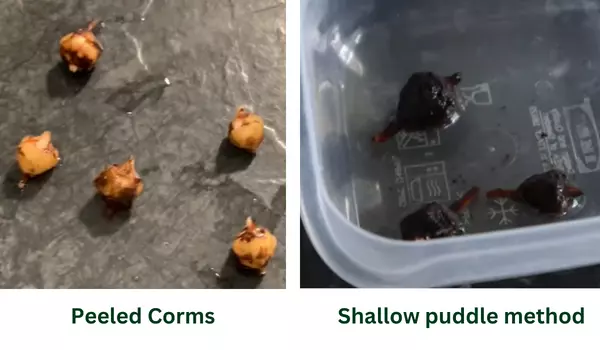
Take a plastic container filled with moist sphagnum moss or LECA and place the corm inside it, facing the tiny pointed tip upwards and the part attached to the root towards the bottom. Keeping it upright is essential for successful propagation, as the pointed tip of the corm will sprout new leaves. Put a small plastic bag or lid over the sphagnum container to create a greenhouse effect. During rooting, the bright indirect light is not essential. You can place the corm containers anywhere, such as the Ikea greenhouse cabinet or grow tent.
Another method to root the corms is the shallow puddle method. Fill a small plastic container with a little bit of water and place the corms in it. The corms should not be submerged in the water completely. Cover the container with a lid and let the corms root.
Once the corms are rooted, transplant the juvenile plant in well-draining potting soil.
Propagation by Tuber Cuts
The Alocasia Frydek is a rhizomatous plant that produces clumps; the petioles emerge from stumps that grow upward from the soil. For mature Alocasias, you might notice lines or circles around the stumps bearing nodes or growing eyes. These are the potential growth points for new buds to shoot.
With age, the stump gets longer and becomes challenging to repot, making the lower end susceptible to rot and turning into mush.
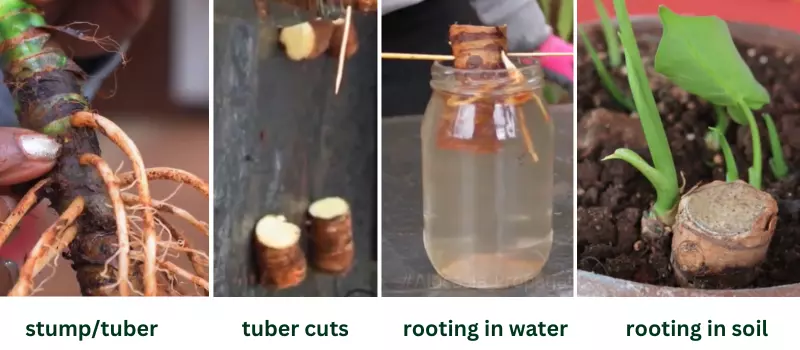
Step-by-Step Guide
Air layering
Air-layering is a non-conventional propagation method for Alocasias but is possible for those Alocasias whose stump grows out of the soil and possesses nodes on it, such as Alocasia Frydek and Cuprea. Alocasia Frydek Variegated is a tuberous plant from where the petioles emerge.
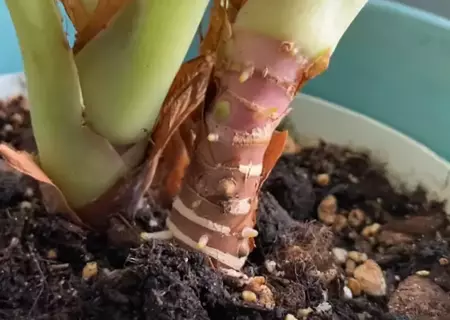
As this plant continues growing, you might notice the stumps grow out of the soil and have lines or circles. Around these circles, you will find nodes or growing eyes- potential points for new growth. The older the plant, the longer the main stem or stump with multiple growth points, making it the perfect candidate for air layering.
Take some sphagnum moss., moisten it and squeeze the excess water. Later cover the stem or stump with nodes and minimal aerial roots with moist sphagnum moss. Wrap the moss with a plastic cover to secure it. The goal is to keep that stem part moist so it can grow roots. After a few weeks, you will notice root growth.
Once you notice ample root growth, you can cut the stem with newly grown roots or behead the plant. Later you can plant the top cutting in a separate pot. The mother plant ( the remaining stem and roots in the potting mix) will grow new leaves and shoot more offsets in a couple of months.

Fertilizer
Alocasia Frydek variegated is a heavy feeder because Alocasias are quite robust growers, and it’s a good idea to fertilize it regularly, especially in the growing season. The plant desires more feed in the active season because it wants more nutrients for its growth; therefore, it is necessary to fertilize it once a month. Frydek Variegated is rhizomatous so it put out rhizomes down below and shoots a lot of offsets and pups .So if you notice these offsets it is time to increase the fertilizing just a little bit.
You can feed the plant half the strength of diluted balanced liquid fertilizer or natural fertilizers rich in nutrients such as worm castings or liquid dirt. It is beneficial to feed organic nutrients such as fish emulsion, worm castings, or compost prevents root burn from a buildup of mineral salts. Moreover, you can use the 1/4 the recommended strength of liquid fertilizer to feed your plant once a week. Always starts with less amount and monitor the results and can increase the dose accordingly.
Some plant parents prefer granular slow-release fertilizer once a month. It releases nutrients slowly when the plant is watered and lessen the chances of foliage or root damage. During the spring and summer seasons, apply fertilizers once a month for active growth and stop fertilizing it in the winter and fall months as the plant goes to dormancy.
Unwanted salt residues can build up over time due to fertilization. Don’t forget to flush out excessive fertilizer every few months by flushing your plant’s soil thoroughly and letting the water drain out completely.

Maintenance and Pruning
The Alocasia Frydek Variegated doesn’t need much pruning, but regular pruning is vital to maintain its health and shape. As the new leaves grow, the older leaves tend to turn yellow and need to trim off as they take up all energy from the fresh foliage. Also, prune the damaged leaves to encourage plant growth. For pruning, use gloves and sterilized equipment to prevent spreading infections.
Remember, Frydek Plant will not become bushier by frequent pruning. It can have 4 to 5 leaves at one time. When pruning dead or dying foliage, cut the leaf petiole near the soil line.

Toxicity
Alocasia Frydek Variegated contains calcium oxalate crystals that proved toxic to humans and pets. This plant can cause mild side effects if ingested, such as skin irritation and mouth and throat swelling. In more severe cases, the consumption may also cause swelling in the digestive tract. Therefore, keeping this plant away from kids and pets is crucial to avoid any unforeseen situation.

Pests, diseases & common problems
Pests
This lovely plant is prone to pest attacks, as these tiny creatures love Frydek’s soft foliage and juicy petioles more than any other houseplant. Spider mites, Aphids, and mealy bugs are the common culprits that can infest your plant. The common signs of pests’ infestation in Alocasia Frydek are yellow, twisted, or curled leaves, stunted growth, and molds on the leaves.
To prevent pest occurrence, take early precautions by checking the leaves regularly and providing a suitable environment for the plant, such as proper lighting, moisture, and watering, as the most common causes of these pests outbreak are dry conditions and overwatering. In case of pest infestation, treat the plant immediately by spraying soap water solution or neem oil.
You can also spray the affected foligae with a mixture of alcohol and water to remove and kill the spider mites. Take 1 cup of alcohol and add 30 Oz of water and pour this solution in the spray bottle. Shake it well and thoroughly spray the plant with this mixture. Let it stay for 30 to 40 minutes and then rise the leaves . Continue spraying every 3 to 4 days until pests are eliminated.
Diseases
The most common diseases in Alocasia Frydek variegated are related to watering. Inappropriate watering may lead to many bacterial and fungal infections, such as root rot and leaf spot. Root rot is the most common and deadly disease, resulting in plant death.
Root rot: The primary cause of root rot is overwatering. When the plant receives more water than required, it accumulates in the soil and may result in damaged leaves and roots. The general signs of root rot are yellowing leaves and mushy black roots.
To avoid root rot in your darling plant, take care of the watering schedule; also, use well-draining and aerated potting soil in a reasonably sized pot with proper drainage holes. Root rot can be treated by repotting the plant in fresh soil.
Fungal Spots: Frequently misting the velvety foliage of Alocasia Frydek Variegated may lead to fungal spots on the leaves. If you notice spots on the leaves, stop misting the plant and place it in a place where it can get enough air flow to dry any water droplets on the leaves. Use a humidifier to increase the humidity around this plant.
Common Problems
As this is a delicate plant, it can encounter many problems if the conditions aren’t in its favour. Some common issues are
Drooping:
The main stressors of Alocasia Frydek are overwatering, nutrient misbalance, and temperature and humidity changes. If your Alocasia Frydek is drooping, identify the problem by looking at each aspect of care and treating the plant accordingly. Sudden environmental changes may cause your Alocasia to drop leaves, a common condition in the fall and winter months. As the plant enters dormancy in these months, it may lose all its leaves and grow them back in spring.
Yellowing leaves:
There are many causes of yellowing leaves, so it’s imperative to know the reason before treating the plant. Yellow leaves may be triggered by overwatering and exposure to direct sun. In addition, some other stress triggers may lead to yellow leaves, such as nutrient toxicity and temperature changes.
Brown leaves:
The foremost cause of leaves browning is excessive sunlight. If you notice crispy and brown leaf edges, it’s an indication that the plant is exposed to direct sunlight. Placing the plant at a location that receives indirect but bright light can solve the issue.
Wilting leaves:
The leaves’ wilting may be caused by underwatering or insufficient sunlight. If you notice leaves wilting of your Alocasia Frydek, consider moving it to a brighter location, where it gets proper light, and also give it a drink to tackle the issue. Moreover, the propagation or repotting of Frydek may cause wilting of leaves due to stress.
Molds on the soil:
The molds on the surface of the potting soil could be caused by two reasons, low light, and overwatering. To contest this issue, replace the top 2 inches of soil and move your plant to a brighter location so that your plant can photosynthesize effectively and the roots can absorb all the water.

Frequently Asked Questions
Is Alocasia Frydek Variegated rare?
Alocasia Frydek variegated is a scarce yet stunning variety of Alocasias. It is hard to get hands on this beauty as it is on the wishlist of almost every plant lover. It’s an attractive houseplant with rich green heart-shaped leaves with white blotches, making it a perfect indoor plant. It runout as soon as it gets in the stores due its high demand.
How do you propagate Variegated Frydek?
The division technique is the easiest and best method for propagating Alocasia Frydek variegated. The suggested season for propagation is early summer when the plant is in a healthy state of growth.
How big can Alocasia Frydek Variegated grow?
Under optimal growing conditions, the plant has the potential to grow up to 2 to 3 feet high, but it can most likely grow up to 2 feet tall indoors. Single rhizome or tuber of this plant can grow four to five leaves at a time.
Should I mist Alocasia Frydek?
If provided with the optimal growing conditions, your lovely Alocasia can grow fast and reach up to 2 to 3 feet tall. Being said that, it is a moderate to fast grower in ideal conditions.
Does Alocasia Frydek like to be rootbound?
Alocasia Frydek likes to be root bound; it does well in a small container with little soil; therefore, there is a seldom need to repot the plant but it’s recommended to repot the plant once in 2 years to maintain its healthy growth.
Is Alocasia Frydek and Green Velvet Alocasia the same?
Alocasia Micholitziana Frydek is a rare variegated cultivar of Micholitziana. Similarly, Green Velvet Alocasia is a widely grown cultivar of same specie Micholitziana but sold with trade name ‘ Alocasia Frydek” and is known as Green Velvet Alocasia due to its dark green velvety leaves.

Final Words
Alocasia Frydek variegated is a stunning houseplant that can make a great statement for your home and office. This elegant plant is commonly known as green velvet Alocasia and elephant ear due to its stunning velvety callosal foliage.
The lush green arrow-shaped leaves exhibiting gorgeous white variegation give it a luscious look, making it a desired houseplant for every plant lover. However, it’s not recommended for beginner gardeners as it’s a hard-to-maintain plant, but after receiving the desired care and love, it shows its true beauty that can lighten up any space.
In short, this Alocasia’s stylish and elegant presence makes it a perfect choice for any home and office. We hope that you have liked this article about the care guide of Alocasia Frydek Variegated, and it will help you to grow this adored houseplant at your place.
Related Posts
Philodendron Melanochrysum Care & Growing Guide
Philodendron ‘Splendid’ is a stunning hybrid of two stunning species of the Araceae family: Philodendron Melanochrysum and Verrucosum.
Philodendron Burle Marx Care & Propagation Guide
The most notable feature of the Philodendron Burle Marx is its large, glossy leaves, which come in heart-shaped or arrow-shaped variations.
Philodendron Scandens-“Sweetheart Plant” Easy Care Tips
Philodendron Scandens, often called the “Heartleaf Philodendron” or the “Sweetheart Plant” is a classic and most loved trailing houseplant.
Philodendron Erubescens ‘Imperial Red’ Care Tips
The Imperial Red Philodendron is easy to grow and can thrive well with little care and attention. Botanically known as Philodendron Erubescens.
Philodendron Ring of Fire Care & Growing Tips
Philodendron Ring of Fire is a striking plant known for its vibrant foliage and is believed a hybrid of Philodendron Wendlandii and P.Tortum.

